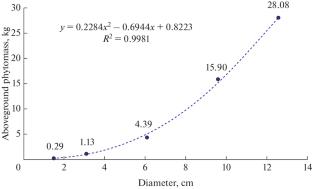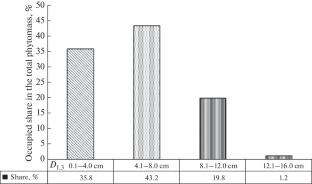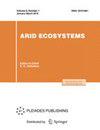蒙古苏赫巴托邦石林博格德山落叶松人工林的地上植物质量
摘要
本研究旨在确定西伯利亚落叶松林分的主要林分特征,并通过生物量组成估算地上乔木生物量分配。蒙古的种植园这项研究是在蒙古苏赫巴托邦的Shiliyn Bogd山脉建立的20年历史的落叶松种植园中进行的,使用的是2年的树苗。研究结果表明,平均直径为8.8 cm,茎高为5.76 m,茎密度为2400 ind. ha-1,茎体积为47.33 m3 ha-1。结果表明,林分特征的平均值与北方天然落叶松幼林的平均值相当接近。研究区地上生物量平均为29.68 T ha-1。结果表明,胸高茎粗与地上生物量呈极显著相关(R2 = 0.99)。选择多项式方程Pkg = 0.228 \(D_{{1.3}}^{2}\) - 0.6944D1.3 + 0.8223作为估算落叶松人工林地上生物量的最优方程。我们的结果显示,相对较高的水分含量比例(69.9%) in aboveground biomass than absolute dry biomass (30.1%). Moreover, biomass component analyses indicated that the dominant part of aboveground biomass belongs to only stem wood (55.5%), and followed by branch (20.0%), bark (15.1%) and needles (9.4%). Based on our assessments we concluded that the establishment of larch tree plantation in the dry-steppe is possible via transplanting of 2-year-old containerized seedlings in Mongolia. The introduction of this afforestation technology plays important contribution to mitigation of land degradation in Central Asia. Therefore, the initial high planting density positively affected to tree survival post-planting period and creation of better microclimate in plantation area. We found that the predominant tree biomass belonged to stem biomass which exceed 55.5% in total aboveground biomass, and the water content amounted for 64% in fresh biomass. The polynomial equation Pkg = 0.228\(D_{{1.3}}^{2}\) – 0.6944D1.3 + 0.8223 was selected most optimal equation to estimate the total aboveground mass. This planting method, planting design and outputs play an important contribution in development of dry steppe afforestation in Central Asia.


This study aimed at determination of main stand characteristics and estimate the aboveground tree biomass allocation by biomass component in Larix sibirica Ledeb. plantations in Mongolia. The study was carried out in 20-year-old Larch plantations established in the Shiliyn Bogd mountains of Sukhbaatar aimag, Mongolia using 2-yr-old seedlings. The results of our assessments showed the mean diameter and height amount for 8.8 cm and 5.76 m, and therefore the stem density and volume were 2400 ind. ha–1 and 47.33 m3 ha–1, respectively. Our findings revealed that mean values of stand characteristics were quite similar to mean values at the natural young larch stands growing in the northern part of the country. Aboveground biomass in the study area was averaged 29.68 T ha–1. We found a strong correlation (R2 = 0.99) between stem diameter at breast height (DBH) and aboveground biomass. The polynomial equation Pkg = 0.228\(D_{{1.3}}^{2}\) – 0.6944D1.3 + 0.8223 was selected as a most optimal equation to estimate aboveground biomass of larch trees in the plantation. Our results revealed a relatively higher proportion of water content (69.9%) in aboveground biomass than absolute dry biomass (30.1%). Moreover, biomass component analyses indicated that the dominant part of aboveground biomass belongs to only stem wood (55.5%), and followed by branch (20.0%), bark (15.1%) and needles (9.4%). Based on our assessments we concluded that the establishment of larch tree plantation in the dry-steppe is possible via transplanting of 2-year-old containerized seedlings in Mongolia. The introduction of this afforestation technology plays important contribution to mitigation of land degradation in Central Asia. Therefore, the initial high planting density positively affected to tree survival post-planting period and creation of better microclimate in plantation area. We found that the predominant tree biomass belonged to stem biomass which exceed 55.5% in total aboveground biomass, and the water content amounted for 64% in fresh biomass. The polynomial equation Pkg = 0.228\(D_{{1.3}}^{2}\) – 0.6944D1.3 + 0.8223 was selected most optimal equation to estimate the total aboveground mass. This planting method, planting design and outputs play an important contribution in development of dry steppe afforestation in Central Asia.

 求助内容:
求助内容: 应助结果提醒方式:
应助结果提醒方式:


